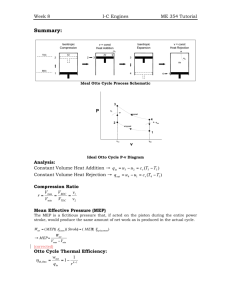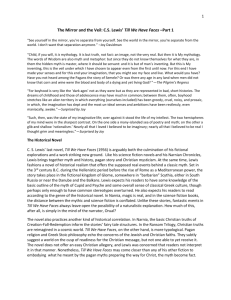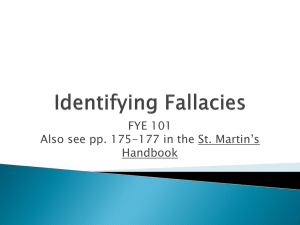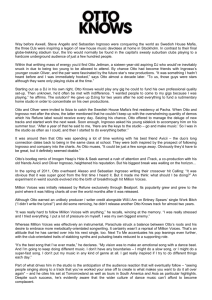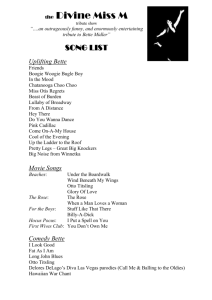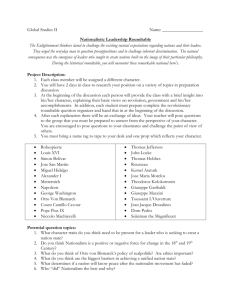Otto's Theory of Religious Experience as Encounter with the
advertisement
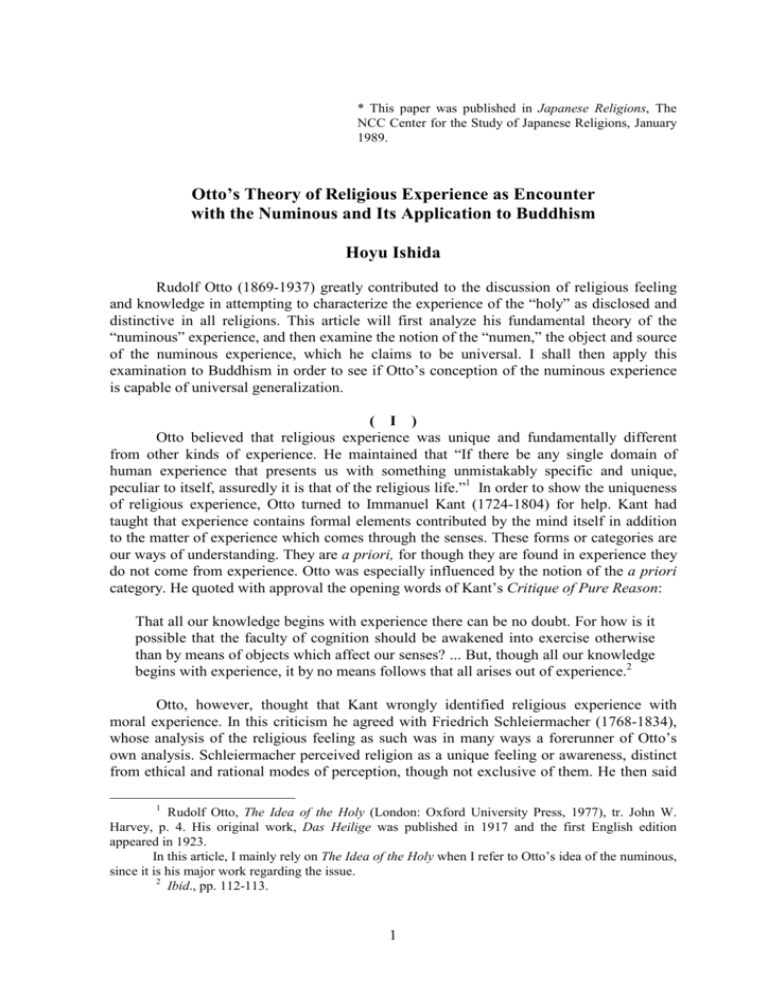
* This paper was published in Japanese Religions, The NCC Center for the Study of Japanese Religions, January 1989. Otto’s Theory of Religious Experience as Encounter with the Numinous and Its Application to Buddhism Hoyu Ishida Rudolf Otto (1869-1937) greatly contributed to the discussion of religious feeling and knowledge in attempting to characterize the experience of the “holy” as disclosed and distinctive in all religions. This article will first analyze his fundamental theory of the “numinous” experience, and then examine the notion of the “numen,” the object and source of the numinous experience, which he claims to be universal. I shall then apply this examination to Buddhism in order to see if Otto’s conception of the numinous experience is capable of universal generalization. ( I ) Otto believed that religious experience was unique and fundamentally different from other kinds of experience. He maintained that “If there be any single domain of human experience that presents us with something unmistakably specific and unique, peculiar to itself, assuredly it is that of the religious life.”1 In order to show the uniqueness of religious experience, Otto turned to Immanuel Kant (1724-1804) for help. Kant had taught that experience contains formal elements contributed by the mind itself in addition to the matter of experience which comes through the senses. These forms or categories are our ways of understanding. They are a priori, for though they are found in experience they do not come from experience. Otto was especially influenced by the notion of the a priori category. He quoted with approval the opening words of Kant’s Critique of Pure Reason: That all our knowledge begins with experience there can be no doubt. For how is it possible that the faculty of cognition should be awakened into exercise otherwise than by means of objects which affect our senses? ... But, though all our knowledge begins with experience, it by no means follows that all arises out of experience.2 Otto, however, thought that Kant wrongly identified religious experience with moral experience. In this criticism he agreed with Friedrich Schleiermacher (1768-1834), whose analysis of the religious feeling as such was in many ways a forerunner of Otto’s own analysis. Schleiermacher perceived religion as a unique feeling or awareness, distinct from ethical and rational modes of perception, though not exclusive of them. He then said 1 Rudolf Otto, The Idea of the Holy (London: Oxford University Press, 1977), tr. John W. Harvey, p. 4. His original work, Das Heilige was published in 1917 and the first English edition appeared in 1923. In this article, I mainly rely on The Idea of the Holy when I refer to Otto’s idea of the numinous, since it is his major work regarding the issue. 2 Ibid., pp. 112-113. 1 that this feeling was man’s “feeling of absolute dependence.” Schleiermacher explained this feeling as the consciousness that one is related to something (the infinite) which totally conditions the individual in every respect, even down to the ground of existence itself. Although Otto was deeply impressed by this idea and credited Schleiermacher for it, he criticized the formulation on the grounds that what Schleiermacher had here pointed up was no more than a close analogy with ordinary, or “natural,” feelings of dependence. This failure to distinguish adequately the feeling of dependence in the natural sense from truly religious feeling was, Otto thought, a flaw in Schleiermacher’s argument. According to Otto, it was a mistake to characterize genuinely religious feeling--an encounter with something that altogether transcends nature--as if it belonged to the same continuum of mundane experiences accessible to the religiously insensitive, or so-called “natural man.” The “natural man,” he said, is “quite unable even to ‘shudder’ (graven) or feel horror in the real sense of the word. For ‘shuddering’ is something more than ‘natural,’ ordinary fear.”3 On another occasion Otto said that, so far as the natural man understands descriptions of the experience of salvation, he: tends to find it [salvation] highly tedious and uninteresting, sometimes downright distasteful and repugnant to his nature, as he would, for instance, find the beatific vision of God in our own doctrine of salvation, or the henôsis of ‘God all in all’ among the mystics. ‘So far as he understands’, be it noted; but then he does not understand it in the least. Because he lacks the inward teaching of the Spirit, he must needs confound what is offered him as an expression for the experience of salvation--a mere ideogram of what is felt, whose import it hints at by analogy-with ‘natural’ concepts, as though it were itself just such an one. And so he ‘wanders ever farther from the goal.’4 Otto held the nature of religious experience to be a special sphere of experience, having its own distinctive characteristics and pattern. There is, accordingly, a category peculiar to religion, which is the idea of the “holy.” This category of the “holy” is a complex category whose constituents are, on the one hand, moral and rational ideas and, on the other hand, an obscure structure of feelings or non-rational elements. Otto said: the ‘holy’ in the fullest sense of the word is a combined, complex category, the combining elements being its rational and non-rational components. But in both-and the assertion must be strictly maintained against all sensationalism and naturalism--it is a purely a priori category.5 Yet, as noted earlier, this non-rational factor or moment is more primordial than the moral and rational ideas which then predominated in the meaning of holy. Otto argued against rationalism in religion: The Ideal of the Holy begins with the argument of rationalism versus non-rationalism. By rationalism, Otto meant the assumption that God or deity can be completely and adequately known by means of concepts, and the tendency to neglect or overlook the unique elements of feeling in religious experience. He held that 3 4 5 Ibid., p. 15. Ibid., p. 35. Ibid., p. 112. 2 there are non-rational depths in the being of God which can be known only in some other way than through concepts. This way is provided by the religious feelings. These, as nonrational intuitions of a transcendent reality, are taken to be immediate, a priori knowledge of the hidden deity. However, “the ‘mysterious’ object” is: beyond our apprehension and comprehension, not only because our knowledge has certain irremovable limits, but because in it we come upon something inherently ‘wholly other’, whose kind and character are incommensurable with our own, and before which we therefore recoil in a wonder than strikes us chill and numb.6 Concepts are thus inadequate to express the wholly other essence of the divine, which cannot be taught but only evoked through introspective reflection. Otto insisted that the terms which are used to express religious experience must not be regarded as genuine intellectual concepts but rather as “ideograms” or “illustrative substitutes for concepts.” For the basic, non-rational element in the idea of the “holy” Otto gave the term “numinous,” derived from the Latin numen. He said: I shall speak, then, of a unique ‘numinous’ category of value and of a definitely ‘numinous’ state of mind, which is always found wherever the category is applied. This mental state is perfectly sui generis and irreducible to any other; and therefore, like every absolutely primary and elementary datum, while it admits of being discussed, it cannot be strictly defined.... It can only be evoked, awakened in the mind; as everything that comes ‘of the spirit’ must be awakened.7 Otto regarded the numinous experience not as a kind of feeling merely, but also exhibiting a category of immediate apprehension and valuation. He distinguished the subjective and objective aspects of the numinous experience. The subjective aspect of the numinous experience is called “creatureconsciousness” or “creature-feeling,” which is “the emotion of a creature, submerged and overwhelmed by its own nothingness in contract to that which is supreme above all creatures.” 8 Otto substituted this “creature-feeling” for Schleier-macher’s “feeling of absolute dependence.” Otto began his exposition with the objective aspect of the numinous experience as he was analyzing Schleiermacher’s defect in his formulation of principle. According to Otto, the position of Schleiermacher was that, “the religious emotion would be directly and primarily a sort of self-consciousness, a feeling concerning oneself in a special, determined relation, viz. one’s dependence.” 9 On the other hand, Otto’s position was that the “creature-feeling” was “itself a first subjective concomitant and effect of another feelingelement, which casts it like a shadow, but which in itself indubitably has immediate and primary reference to an object outside the self.”10 The objective aspect of the numinous feeling is, Otto explained, the experience of a mysterium which has two primary modes--a 6 Ibid., p. 28. Ibid., p. 7. 8 Ibid., p. 10. 9 Ibid., p. 10. 10 Ibid., p. 10. 7 3 feeling of religious awe or dread (tremendum) and a feeling of religious fascination (fascinans). Here it might be objected that if the “objective aspect” of the numinous feeling is just dread and fascination, then it begins to look as if this aspect is itself still within the realm of subjective feeling. Thus, Otto’s analysis would appear to suffer from the same defect as Schleiermacher’s: namely, that a feeling-centered interpretation of religious experience cannot by itself determine a concrete objective referent. It may be that Otto fell into this difficulty, and his theory would to that extent be inconsistent. We can be certain, however, as “interpreters” of Otto (and interpretation must precede criticism), that for him the numinous feelings of dread and fascination must refer to a non-subjective Other which utterly transcends the self and is “wholly other.” In any case, the closest analogue to the first feeling of religious dread or awe is the feeling of “something uncanny,” “eerie,” or “weird.” It is the feeling one has when the hair on the back of one’s neck rises, the shudder or terror on hearing a ghost story, the dread of haunted places. This is the feeling of “awfulness,” which is inspired by the numinous and must be sharply distinguished from mere natural fear. There are two other different kinds of feeling of tremendum or religious awe--the tremendum of majestas or “overpoweringness” and that of “energy” of urgency. The tremendum of overpoweringness is based on a sense of the infinite which swallows up everything finite. This experience of numinous majestas is the objective element of which “creature-consciousness” in the subjective concomitant. Mysticism develops these experiences into the conceptions of the sole reality of the transcendent, and of the annihilation of the self. It is the “feeling of our creaturehood” and “the consciousness of the littleness of every creature in face of that which is above all creatures.”11 The tremendum of energy or urgency is the irrepressible impression of the numen’s activity as an agency set over-against the entire natural world. For the divine object cannot be supposed a passively subsisting entity, principle, or law, whose recognition as such and specific applications would then depend upon the human subject. No--this numen rises up spontaneously and of its own accord to manifest its limitless power over all things. (Here, incidentally, is another indication that for Otto the numen was an unambiguously external and independent object.) The tremendum of energy clothes itself everywhere in symbolic experience such as “vitality, passion, emotional temper, will, force, movement, excitement, activity, impetus.”12 It is because of this element in numinous experience that religion cannot, according to Otto, be satisfied with a God who is a mere abstraction, but insists upon the reality of the “living” God.13 The numinous experience has another phase in which the “wholly other” is revealed as profoundly attractive and fascinating. This more positive side of the experience lies at the root of mystical bliss, divine ecstasy, etc. By analogy it suggests the divine attributes of “love, mercy, pity, comfort”14 interpreted, again, as ideograms. Otto held that hymns and doctrines of salvation and the imagery of eschatology are efforts to give expression to these moments of numinous feeling. This feeling of fascination creates the desire to approach the divine object despite the simultaneous feeling that one possesses no value when considered in relation to the fascinating and prized object. 11 12 13 14 Ibid., p. 22. Ibid., p. 23. Ibid., p. 24. Ibid., p. 31. 4 The kind of mysticism that Otto deals with is based on the notion of religious experience of non-rational or numinous objects. Mysticism is, according to Otto, “the stressing to a very high degree, indeed the overstressing, of the non-rational or suprarational elements in religion; and it is only intelligible when so understood.”15 For Otto, the essential basis of mysticism is a strong sense of the non-rational and numinous character of the religious object. He was not interested per se in “varieties of religious experience” as William James was. For Otto insisted upon interpreting the numinous or holy as an a priori category, which is to be disclosed in any religious experience. There is a fundamental difference in theory between Otto and William James, who questioned whether all religious experiences contained anything of a universal psychological character. James defined religion as “the feelings, acts, and experiences of individual men in their solitude, so far as they apprehend themselves to stand in relation to whatever they may consider the divine.”16 Although James did not conclude that religion was an illusion (as Sigmund Freud later explicitly did), James was not specifically interested in examining “whatever [men] may consider the divine.” He was instead interested in judging “the religious life by its results exclusively”17 and empirically. On the other hand, Otto maintained the reality of an a priori category, like the holy or the numinous. Though he said the numinous is not necessarily experienced by everyone, everyone is capable of experiencing it, and in that sense it is universal in mankind. The religious consciousness has its own innate structure and makes use of its own a priori categories. ( II ) Now this object is just what we have already spoken of as ‘the numinous.’ For the ‘creature-feeling’ and the sense of dependence to arise in the mind the ‘numen’ must be experienced as present, a numen praesense, as is in the case of Abraham. There must be felt a something ‘numinous’, something bearing the character of a ‘numen’, to which the mind turns spontaneously; or (which is the same thing in other words) these feelings can only arise in the mind as accompanying emotions when the category of ‘the numinous’ is called into play. The numinous is thus felt as objective and outside the self. (emphasis mine)18 Otto’s claim that the numinous feeling signifies the presence of some particular kind of object, the numinous, is susceptible of some criticism. This claim needs to be verified. Otto explains that this numinous is beyond our comprehension and understanding and has to be awakened in one’s mind through the numinous experience. This explanation of the numinous experience, however, does not necessarily prove that its object, a supposedly transcendent something which is “wholly other” than the subject, exists. This claim was avoided by James, and when it came to Sigmund Freud, he negated the object of religion as an illusion and made his new claim that religion was derived from man’s wishfulfillment. It is not necessary for our purposes to discuss or decide which claim, Otto’s or 15 Ibid., p. 22. William James, The Varieties of Religious Experience (New York: New American Library, 1958), p. 42. The first English publication appeared in 1902. 17 Ibid., p. 35. 18 Otto, p. 11. 16 5 Freud’s, is the right one. While Freud is extremely reductive, however, in his interpretations and conclusions about religion, Otto’s theory of the numinous or holy as the a priori is a little hypothetical to the extent that he includes Buddhism. Otto believed that the numinous experience is universal. In explaining that Buddhism also reported similar religious experiences, Otto said: what is true of the strange ‘nothingness’ of our mystics holds good equally of the sûnyam and the sûnyatâ the ‘void’ and ‘emptiness’ of the Buddhist mystics. This aspiration for the ‘void’ and for becoming void, no less than the aspiration of our western mystics for ‘nothing’ and for becoming nothing, must seem a kind of lunacy to anyone who has no inner sympathy for the esoteric language and ideograms of mysticism, and lacks the matrix from which these come necessarily to birth. To such an one Buddhism itself will be simply a morbid sort of pessimism. But in fact the ‘void’ of the eastern, like the ‘nothing’ of the western, mystic is a numinous ideogram of the ‘wholly other’.19 When Otto was talking about the “fascination” of the numinous experience, he again said: I recall vividly a conversation I had with a Buddhist monk. He had been putting before me methodically and pertinaciously the arguments for the Buddhist ‘theology of negation’, the doctrine of Anâtman and ‘entire emptiness’. When he had made an end, I asked him, what then Nirvana itself is; and after a long pause came at last the single answer, low and restrained: ‘Bliss--unspeakable’. And the hushed restraint of that answer, the solemnity of his voice, demeanour, and gesture, made more clear what was meant than the words themselves.20 Though Otto was showing his sympathy to Buddhism, he was interpreting it in the context of his own understanding of religious structure. He seems to have uncritically interpreted Buddhism through the eyes of his personal understanding and placed it wherever it fit into his analysis of religious experience by invoking the concept of the numen as an a priori category. Therefore, although Otto’s presentation of religious experience in Buddhism does have some plausibility, it does not necessarily prove that Buddhism involves the experience of the “numinous” in Otto’s sense. Ninian Smart, in his Reasons and Faiths, distinguishes the religious experience of Buddhism from that of prophetic traditions like Christianity. Smart argues that certain strains of Buddhism differ markedly from such prophetic religions as Christianity, Judaism and Islam, in that the religious experience most characteristic of the former is “mystical,” whereas that most characteristic of the latter is “numinous.”21 Although Otto himself in his other work, Mysticism East and West, applied the term “mysticam” to the experience of both Meister Eckhart and Acharya Shankara, the underlying theme is always the numinous experience, which had been already developed and discussed in The Idea of the Holy. It is clear that Otto did not distinguish the numinous experience from the mystical experience. 19 Ibid., p. 30. Ibid., p. 39. 21 Ninian Smart, Reasons and Faiths: An Investigation of Religious Discourse, Christian and Non-Christian (London: Routledge & Kegan Paul, 1958). 20 6 A numinous experience, Smart suggests, following Otto, is one of an encounter with a being wholly other than oneself and altogether different from anything else. Such an encounter is usually said to be “gratuitous,” in the sense that those subject to it are not themselves responsible for its occurrence, and it is typically described as both overwhelming and self-authenticating. The mystical experience, by contrast, is not so much an encounter with a “sacred other” or a divine as it is the interior attainment of a certain extraordinary, enlightened state of mind. Such an attainment is usually held to be the result of the subject’s own efforts in following a certain contemplative discipline or method. Among the qualities typically ascribed to mystical attainments are bliss, ineffability, absence of a distinction between subject and object, timelessness, etc.22 Smart’s useful distinction between “numinous” and “mystical” experience should not be pushed to an extreme, however. We will now examine the fundamental difference in principle between Otto and Buddhism in general. Our purpose in what follows will not be to prove one theory or the other, but merely to show that Buddhism, by offering a perspective which is at least as plausible as Otto’s account, calls into question the a priori status he attributed. The basic difference between these two accounts seems to lie in a treatment of a concept of “soul.” Otto started his theory consciously or unconsciously with affirming the very existence to soul as an ontological principle, though his notion of “soul” is not very clear. On the other hand, Buddhist teaching begins with analyzing the ontological status of the “soul” and then gives a negative judgment of this validity. What Buddhism tries to negate is a notion of âtman (soul or self), which is the supposedly unchanging substance behind the changing process of consciousness. As Buddhism claims that everything is constantly in a process of changing and transforming, the “soul” that we believe exists as an entity or substance transforms as well and does not exist even for a moment, as an unchanging essence. According to Buddhist philosophy, what we call a “being,” or an “individual” or “I” is only a combination of ever-changing physical and mental forces or energies, which may be divided into five groups or aggregates (pañcaskandha). They are the aggregates of matter (rûpaskandha), sensations (vedanâskandha), perceptions (samjñâskandha), mental formulations (samskâraskandha) and consciousness (vijñânaskandha). What we call a “being” is then only a convenient name or a label given to the combination of these five groups. They are all impermanent, all constantly changing. Buddhism hence develops a doctrine of anâtman (“no-soul” or “no-mind”), which of course does not mean that there is no concept of ego or self, but just that such a concept has no objective referent (there is “no-soul”). Buddhism sees that life is essentially duhkha (“suffering”). 23 The cause of 22 Many philosophers have elaborated the concept of transcending the subject-object distinction. For example, Kitarô Nishida (1870-1945), a Japanese philosopher, refers to this experience as “pure experience,” in which there is only experience taking place and no recognition of an opposition between the subject (one that perceives) and the object (one that is perceived). He expounds on “pure experience” in the opening page of his early work. Zen-no-kenkyû, (1911; Eng. trans., A Study of Good, 1960). 23 The term duhkha, is often translated as “suffering” but needs some explanation. The Buddha does not deny happiness in life when he says there is suffering. On the contrary, he admits different forms of happiness, both material and spiritual, for laymen as well as for monks. In the Anguttaranikâya, there is a list of different kinds of happiness (sukhâni), such as the happiness of family life and the happiness of the life of recluse, the happiness of sense pleasures and the happiness of renunciation, the 7 suffering is derived from one’s ignorance, which gives rise to one’s attachment or clinging to the phenomenal world. Buddhism maintains that, since absolutely nothing is permanent, man gets dissatisfied with the way the world is because of its impermanent nature: while the world is impermanent, man’s clinging to it is innate. The essential cause of man’s suffering is then focused on his clinging to his self or ego. Buddhism here theoretically concludes that the achievement of “no-soul” or “no-self” brings about the extinction of all suffering. This extinction is the goal of Buddhist teaching, and its consummation is nirvâna (which literally means “extinction”). According to Buddhism, the belief in soul as a substantial entity is a delusion. In examining the Buddhist doctrine of “no-soul,” we find an essential difference in principle between Otto and Buddhism. There are certain Buddhist traditions which to some extent do seem comfortable to Otto’s analysis in terms of the divine as a separate reality, external to the individual devotee. Pure Land Buddhism, for example, presents Amida Buddha as separate entity, though we still find some fundamental differences between Otto’s idea of the numinous and Amida. Pure Land Buddhism seemingly differs from early or general Buddhism which explicitly spells out notions like “no-soul” and the five aggregates. The Pure Land tradition does not emphasize the notion like “no-soul” as much but instead incorporates the saving deity, Amida. In this respect, Pure Land Buddhism is close to Christianity. According to Shinran (1163-1272), the founder of Jôdo Shin-shû or Shin Buddhism in Japan, there are two kinds of dharmakâyâ (hosshin in Japanese, meaning “dharmabody”) regarding the Buddha. The first is called dharmakaya-as-suchness (hosshô-hosshin) and the second, dharmakaya-as-compassion (hôben-hosshin). Hosshô or suchness is reality itself as it is and hôben (upâya in Sanskrit) is expediency or skillful means. Shinran says in his Note on ‘Essentials of Faith Alone’: Dharmakaya-as-suchness has neither color nor form; thus, the mind cannot grasp it nor words describe it. From this oneness was manifested form, called dharmakayaas-compassion. Taking this form, the Buddha proclaimed his name as Bhiksu Dharmâkara and established the forty-eight great Vows that surpass conceptual understanding. Among these Vows are the primal Vow of immeasurable light and the universal Vow of immeasurable life, and to the form manifesting these two Vows Bodhisattva Vasubandhu gave the title, “Tathagata of unhindered light filling the ten quarters.” This Tathagata has fulfilled the Vows, which are the cause of his Buddhahood, and thus is called “Tathagata of the fulfilled body.” This is none other than Amida Tathagata.24 It is clear that Amida is not merely the “wholly other” object or source like the numinous we have seen, but the dharmakaya-as-compassion--the constituent of wisdom (infinite light) and compassion (infinite life)--by which, it can be understood, one is to realize suchness or ultimate reality in the end. Of course, Amida is true, real and vivid to the advocate in a religious sense, but in the context of Buddhism as a whole, it can be claimed happiness of attachment and the happiness of detachment, physical happiness and mental happiness etc. All these are included in duhkha, since the conventional happiness is conditional and turns into unhappiness when it is not granted because of the impermanent nature of the phenomenal world. 24 Shinran, Notes on ‘Essentials of Faith Alone,’ Shin Buddhism Translation Series (Kyoto: Hongwanji International Center, 1979), p. 43. 8 that the teaching of Shin Buddhism plays a role as an upâya, by which one is to be led to enlightenment, to the goal of “no-soul,” which will take one to nirvâna eventually. The Pure Land devotee experiences this “no-soul” by finally letting go of his or her ego through the saving power of Amida Buddha. We see that Buddhism includes in its negation of the “soul” a corresponding negation of the total objectivity and separateness of the divine. There is no opposition between majestas and “creature-feeling.” In sharp contrast, Otto’s conception of the numen as tremendum mysterium et fascnans presupposes the notion of an independent “soul”--i.e. separate reality within oneself--which one experiences as being another reality opposed to oneself. The sense of sin and guilt which Otto makes so much of is, significantly, absent in Buddhism, including the Pure Land tradition. Buddhism claims that the fears experienced by the soul are not real since the “soul” itself is not real and a mere concept. The belief in one’s distinctive and independent “soul” is a delusion, and getting rid of this delusion is the way of escaping from the ignorance and the attachment which are the cause of suffering. As we have seen, there are cases of religious experience in which people attain salvation without the presuppositional idea of the subject-object distinction and all that it entails.25 This fact raises questions concerning the notion of the numinous as a universal and a priori category. The question will be raised why one has to claim that the feeling of sin or guilt is vital or why the numinous, the so-called “encounter” with a divine object, have to be sui generis and an a priori category for the religious experience. There may indeed be another way of having a religious experience. Otto at least cannot prove that one must experience the particular sense of “soul” or Spirit in order to be religious. Between the basic assumptions of Buddhism and those of Otto, there lies a certain difference in dealing with issues, though both result in occasionally similar accounts and conclusions. In broad terms they both agree, as Otto said, on the feeling of nothingness on the side of the one who experiences and the incomprehensibility of the experience, etc. But Otto adds an ontological superstructure which involves him in many assumptions. I do not mean to make any judgment as to which system, “no-soul” or “soul,” is in the final analysis correct. However, the idea of “soul” needs to be examined more carefully and the notion of the numen or the divine, the object of the numinous experience, has to be verified, if one is to make a claim that the numinous experience based on the numen as an a priori category is universal in all religions, as Otto tried to do. Otherwise, it remains only a hypothesis. Otto’s theory appears to be at its weakest as an interpretation of a religion like Buddhism, though he might possibly be able to make a convincing case that the numinous is peculiar to the religious traditions of the West. (Japanese Religious NCC Center for the Study of Japanese Religions, Kyoto, Vol. XVI, No. 4, pp. 17-25.) 25 The issue, in fact, is rather more complex, especially when it comes to the Pure Land tradition of Buddhism, which I would like to discuss in a future article. 9
